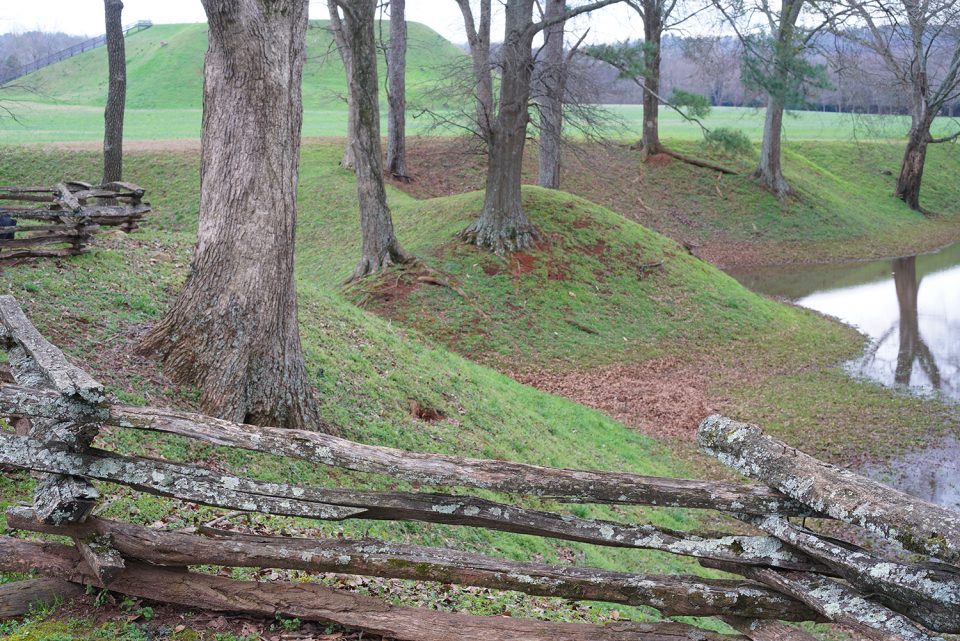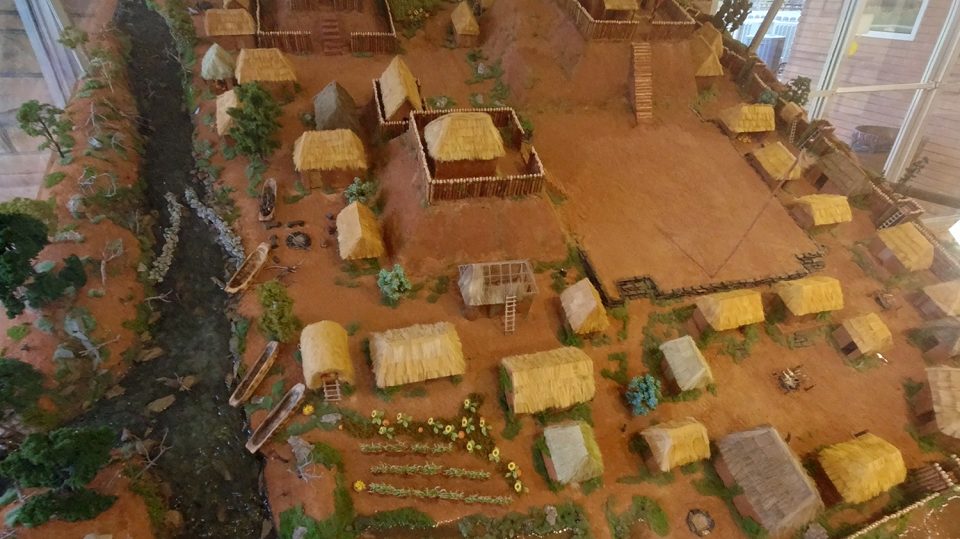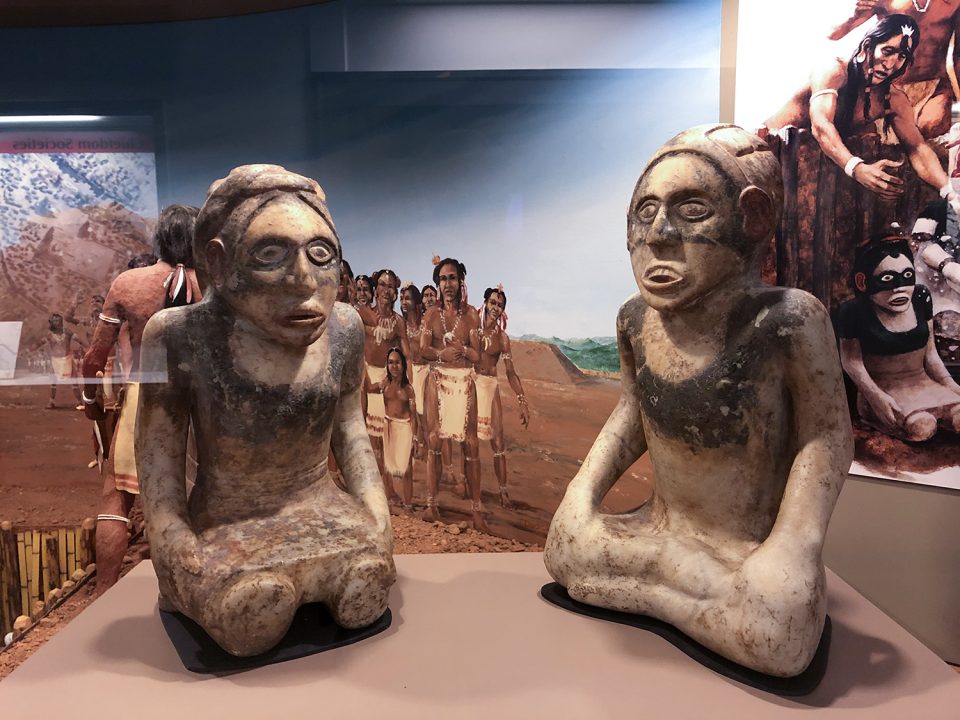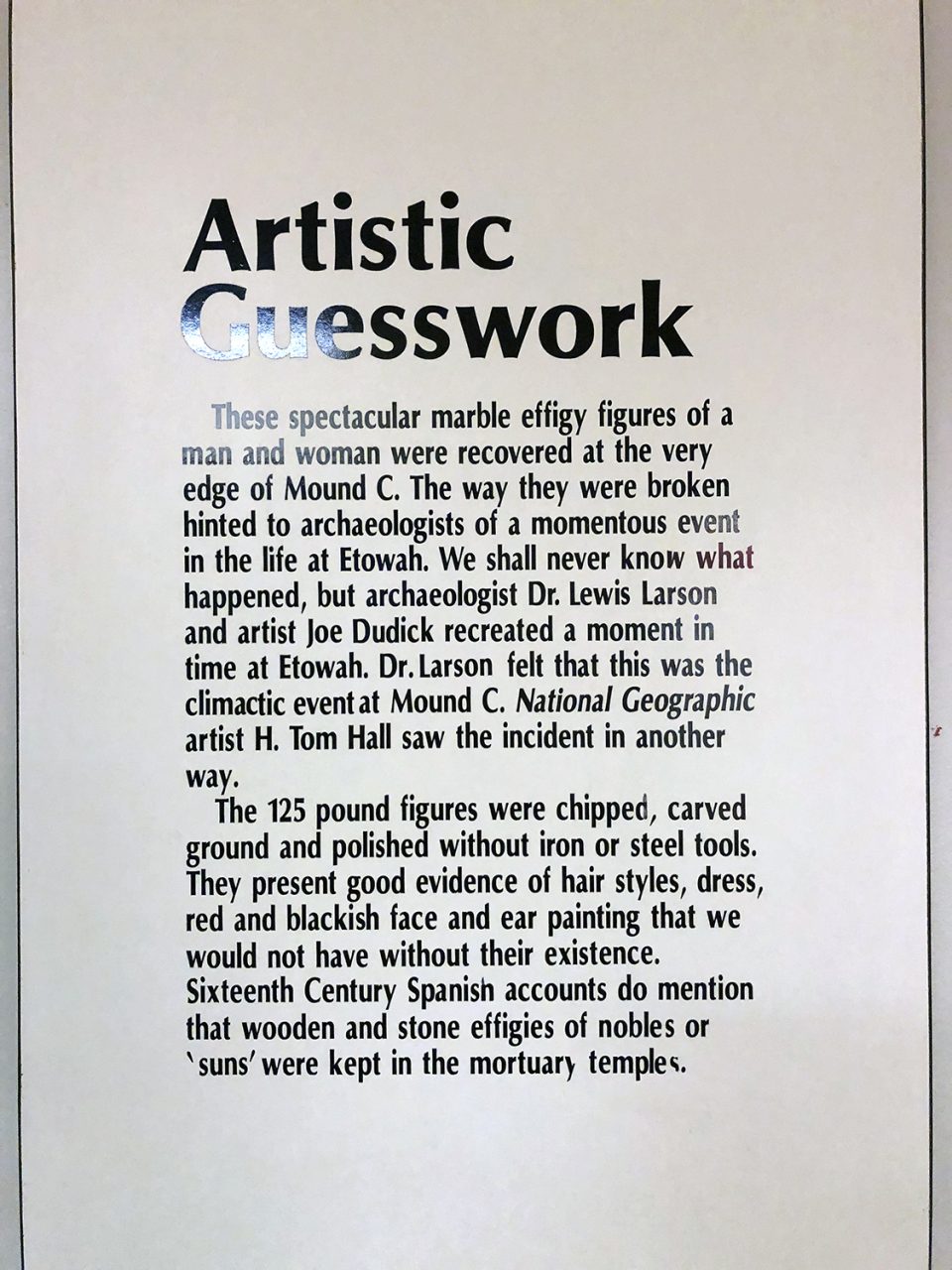Georgia mound site is spectacular, but the marble statues steal the show
The magnificent mound site at Etowah, in NW Georgia at Cartersville, was occupied by prehistoric people from about 1,000 – 1,550 AD. It was occupied by potentially several thousand people of the Mississippian culture, which predated the ascendance of more modern Native American tribes like the Cherokee. The Etowahans were ancestors of the Muscogee Creek people (1).
The Mississippian culture (approximately 800 – 1600 AD) was an overarching society that shared many common religious, artistic, and social practices in villages across the Southeastern US and the Midwest. Scholars have labelled a certain group of these communities under the name Southeastern Ceremonial Complex (see a list of the member locations down the page). Although these villages shared cultural traits and participated in active trading relationships, warfare was apparently a significant part of existence during the Mississippian era.

Organization of the village at Etowah
Mississippian villages were remarkably consistent from location to location in their civic design. Like others I’ve visited (including Cahokia, Aztalan, and Sellars Farm), Etowah consisted of several mounds, a central plaza, a village of huts, plots of land devoted to crops, a wood and mud palisade for protection, a river along the boundary of the village, and defensive ditches outside the wall.
The largest mound at Etowah (Mound A) was 63 feet tall and held structures on top — probably a home for the chieftain. Smaller mounds at Etowah included Mound B, a temple mound also topped by a structure, and Mound C, which was a burial mound. A few smaller mounds are now barely detectable.

Because the mounds were topped by temple structures and share some similar artistic motifs, some scholars historically thought this culture may have been influenced by trading visits to Mexico, where pyramids topped by temples had been built. More recently, this line of thought about a connection to Mexico has been discounted (2).
Below the large mound at Etowah was a raised plaza, used for ceremonies, gatherings, and games. Around this were small red-clay huts made from walls of woven sticks (waddle) sealed with mud (daub). Huts were topped with thatched roofs with a hole in the middle which allowed smoke from a central hearth to escape.
Below is a video of a reconstructed hut like those believed to have existed at Etowah.
Waddle and daub hut with a thatched roof at Etowah Mound Site
Trade and Warfare
Like many Mississippian sites, the location was bounded partially by a river. The Etowah River provided a valuable source of water and food. It featured dozens of rock fish dams, which made it easier trap and catch fish. Rivers also provided a means to travel and trade with other villages.
Trading was extensive, and the artistic artifacts found at Etowah contain materials that came from far away. Marine shells were imported from the gulf coast. Mica, flint, and copper came from Tennessee. Ochre pigments, graphite, and marble were brought in from distant regions.
All Mississippian culture villages were surrounded by high palisades made of tall wooden poles packed with mud like adobe walls. Etowah’s wall featured guard towers and a deep outer ditch resembling an Old English moat, which was dug to supply material for building the mounds. A perimeter of trees helped protect the town from flaming arrows from enemy archers (1).
War trophies such as human heads, limbs, and skulls (as well artistic representations of such war trophies) were an important part of ceremonial symbolism and may have been key aspects of power for chieftains (3). Ceremonial war axes made of stone were found at Etowah and other mound sites. The primary threat to the residents of Etowah may have come from the people of the site at Moundville, Alabama.
Carved stone statues
One of the biggest surprises to me was learning that Native Americans of the Mississippian era carved stone statues. Known as effigy statues, these remarkable works of art were important religious and community symbols. A matched male/female pair were discovered at Etowah. Matched couples were often representative of very important figures to a community — perhaps the founding ancestors of the village. While they vary slightly in style from place to place, these statues follow some common rules. For example, the men are typically seen sitting cross legged, while women sit on their legs.
The Etowah pair are displayed side-by-side in the museum on the Etowah archaeological site. I’d previously seen statues found at Sellars Farm, near Nashville, which were carved from siltstone. The Etowah pair are carved from marble. They show residual colors that are hundreds of years old.
For me, the statues are a remarkable connection to these long-gone people. I find them very powerful symbols.



Mound sites associated with the Southeastern Ceremonial Complex
This is NOT a complete list of Native American mound sites, only those associated with the cultural practices of the Southeastern Ceremonial Complex
Alligator Effigy Mound (Ohio)
Angel Mounds (Indiana)
Cahokia (Illinois)
Castalian Springs Mound Site (Tennessee)
Etowah Indian Mounds (Georgia)
Kincaid Mounds State Historic Site (Illinois)
Kolomoki Mounds (Georgia)
Lake Jackson Mounds Archaeological State Park (Florida)
Mangum Mound Site (Mississippi)
Moundville Archaeological Site (Alabama)
Ocmulgee National Monument (Georgia)
Serpent Mound (Ohio)
Spiro Mounds (Oklahoma)
Town Creek Indian Mound (North Carolina)
Wickliffe Mounds (Kentucky)
Learn more about Etowah and Mississippian culture
Below are a few books on the subject of Etowah and the broader Mississippian culture. I’m currently reading the first one, Ancient Objects and Sacred Rituals, which happens to feature the statues from Etowah on its cover. I’m not far into it, but it’s a fascinating topic to read about.

Ancient Objects and Sacred Realms: Interpretations of Mississippian Iconography
Edited by F. Kent III Reilly and James F. Garber, Foreword by Vincas P. Steponaitis

Visualizing the Sacred: Cosmic Visions, Regionalism, and the Art of the Mississippian World
edited by George E. Lankford, F. Kent Reilly, and James F. Garber

Exploration of the Etowah Site in Georgia: The Etowah Papers
by Warren King Moorehead

Mound Sites of the Ancient South: A Guide to the Mississippian Chiefdoms
by Eric E. Bowne
Books about Cahokia
Cahokia mound site was the largest city in North America, and for a while had a population larger than London at that time. With over 120 mounds in its day (and 80 still in existence) it was essentially the mother ship for Mississippian culture.

Cahokia: Ancient America’s Great City on the Mississippi
by Timothy R. Pauketat

Ancient Cahokia and the Mississippians (Case Studies in Early Societies)
by Timothy R. Pauketat
Note: These books are offered by Amazon. I may earn a small commission from qualifying purchases.
Thanks for reading.
Be sure to visit me on Facebook, Instagram or Pinterest, or on my website at keithdotson.com.
~ Keith
Sources
1. Wikipedia: Etowah Indian Mounds
2. Wikipedia: Southeastern Ceremonial Complex
3. Ancient Objects and Sacred Rituals, Kent Reilly III and James F. Garber, University of Texas Press, 2007, pg. 153-154
